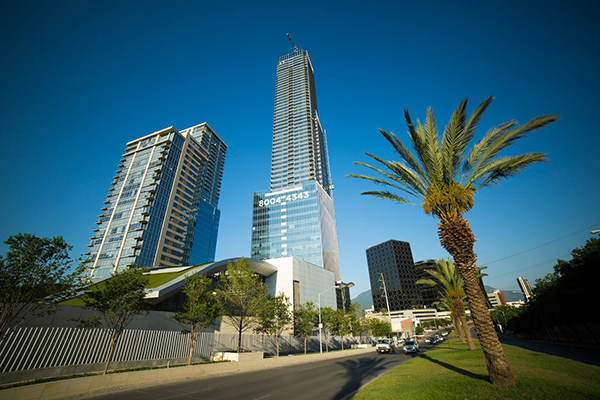
Vitro Architectural Glass released the results of an extensive, post-occupancy, energy-performance study titled, “True Story of a Successful Façade: A Proven Case of Savings, Comfort and Aesthetics.”
About the study
The analysis documents the energy performance of the 68-story KOI Tower in Monterrey, Mexico. The country’s second-tallest building features a facade composed primarily of double-pane insulating glass units fabricated with Solarban R100 Optiblue glass by Vitro Glass. According to the study, the façade is helping to deliver annual operational cost savings of almost $600,000, which could potentially equate to more than $25.5 million in savings over the life of the building.
While the occupant comfort and aesthetics of high-performance glass facades are well documented, the financial advantages of their use can be difficult to quantify. Seeking to address the misconception that sustainably designed buildings require higher initial investment than more conventional structures, Vitro Glass hired Three Consultoría Medioambiental, an independent environmental consulting firm, to systematically evaluate KOI Tower’s cost savings, profitability, and occupant comfort levels over three years of operation and compare them to other glass systems.
What the study found
Real information on energy consumption/electricity costs, mechanical HVAC equipment costs, and glazing types as well as the comfort level of its occupants were used to obtain quantitative conclusions and monetize the benefits. Using Trace 700 virtual building software, the consulting firm found that the installation of Solarban R100 Optiblue glass on the tower enabled it to operate with 28 percent fewer tons of cooling capacity. The related benefits, including the use of smaller HVAC equipment, which requires less labor to install and less power to operate, and smaller duct sizes, translate into annual energy savings of $589,880, according to the firm’s modeling.
The study also showed that Solarban R100 Optiblue glass allowed only 49 percent of the ambient solar heat to pass through its surface. This is a significant reduction compared to the baseline performance of 12-millimeter uncoated monolithic clear glass, which showed 76 percent of the building’s total floor thermal load entering through the glass façade.
To further measure solar radiation, thermal comfort, and natural lighting, Three Consultoría Medioambiental utilized Integrated Environmental Solution’s IESVE7 program. Using this software, the firm calculated a 15.7 percent improvement in thermal comfort and a 13.7 percent reduction in glare as compared to the baseline 12-millimeter clear monolithic glass. The firm’s analysis also determined that Solarban R100 Optiblue glass helped provide thermal comfort to building occupants 90 percent of the time, despite Mexico’s warm, semi-arid climate.
“The evidence collected with this study demonstrates that it is possible to have a high-performing glazing system and recover your investment immediately, in addition to enjoying the constant savings and qualitative benefits (comfort) that this type of glass provides,” the study states.
Further quantifying the building’s level of sustainability, the study found that more than 73,000 tons of carbon emissions will be mitigated over the life of the structure, which is equivalent to removing 36,979 vehicles from the road.
More about IGU and KOI Tower
The double-glazed, insulating glass system also contributes to the structural stability of the wind-challenged KOI Tower. A neutral-reflective, low-e glass with a steel-blue gray aesthetic, Solarban R100 Optiblue glass has a solar heat gain coefficient (SHGC) of 0.20, visible light transmittance (VLT) of 30 percent, and a U-value (thermal insulating value) of 0.29.
Opened in 2017, KOI Tower has 27 floors of leasable commercial space and 37 floors of residential living space. The building is LEED-certified at the Silver level and is the tallest tower in Mexico to achieve this distinction.

